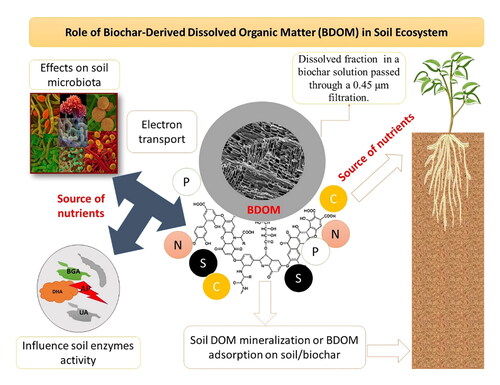

Biochar-derived dissolved organic matter (BDOM) plays key roles in soil ecosystem by affecting soil physicochemical and biological properties and supplying nutrients to soil microbes. It can either enhance or suppress the growth of certain soil microorganisms, depending on its composition and content of labile organic compounds. This review aims to discuss and summarize the role of BDOM in modifying soil microbial functioning, microbial community structure, and enzymatic activity. We mainly focus on the role of BDOM as a function of its concentration, type of feedstock biomass, and pyrolysis temperature (PT). Results show that saw dust- and manure-based biochars produce higher BDOM concentrations than straw-, bone-, and sludge-based biochars. The types of feedstock biomass and its PT determine BDOM characteristics and its interaction with soil microbial communities. Plant-derived biochar with pyrolysis temperature ≤300°C often results in a more aliphatic BDOM than that with pyrolysis temperature ≥500°C, which yields a more aromatic BDOM. BDOM of plant biochar contains higher specific ultraviolet absorbance (SUVA) and humification index (HIX) than that of manure biochar. The SUVA and HIX of BDOM positively correlate (R2=0.68–0.96) with the content of total fatty acid methyl esters, but negatively correlate with the abundances of actinomycetes, arbuscular mycorrhizae, and fungal communities. However, the environmental fate of BDOM in biochar amended soil requires long-term experiment, both in laboratory and field scales, to provide a full understating of BDOM interaction with soil organic matter and microorganisms and help to tailor a safe utilization of biochar in agroecosystems.
